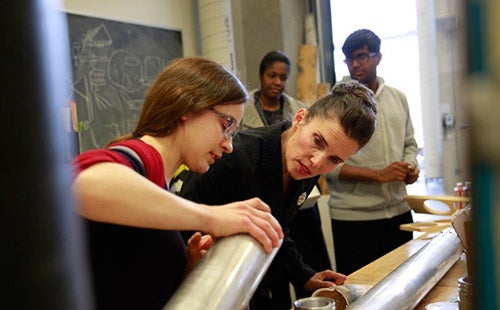
Federal Minister of Science visits University of Waterloo
Minister meets students in the Institute for Quantum Computing, Velocity Science program and the Sedra Student Design Centre

Minister meets students in the Institute for Quantum Computing, Velocity Science program and the Sedra Student Design Centre
By Katrina Schigas Marketing and Strategic CommunicationsCanada’s Federal Minister of Science, the Honourable Kirsty Duncan, toured the University of Waterloo’s innovative research spaces this week to learn about how innovations developed here will fundamentally change the fabric of society.

“You come to a place like this and you feel the energy of the university and all the fields coming together,” said Duncan. “It’s phenomenal; it’s exciting.”
Minister Duncan met with officials from the Institute for Quantum Computing where Executive Director Raymond Laflamme explained how Waterloo is harnessing the laws of nature to improve the human condition.
“Some technology changes the fabric of society,” said Laflamme. “The Institute for Quantum Computing is the beginning of a new era of information processing. Quantum algorithms will have an impact on health science and natural resource extraction, not just quantum theory.”
Duncan noted the unique opportunities Waterloo provides students, from the exceptional co-operative education program to the innovative intellectual property policy and multidisciplinary research strengths.
Duncan toured the Mike & Ophelia Lazaridis Quantum Nano Centre where she had the opportunity to meet with students and learn about their research, stating that she was “in awe” of the work that was taking place. “It’s exciting to know that the Government of Canada has such a keen interest in what we’re doing,” said PhD student Jeff Salvail.
Duncan also met with student entrepreneurs in the Velocity Science Program, which provides mentorship and resources to startups in the life and physical sciences, and toured the Sedra Student Design Centre, a state-of-the-art student-led engineering design centre which is the largest of its kind in North America.
“I thought I knew Waterloo,” said Duncan. “It’s such a different philosophy here; it’s amazing.”

Read more
Here are the people and events behind some of this year’s most compelling Waterloo stories

Read more
Meet five exceptional Waterloo graduate students crossing the convocation stage as Class of 2025 valedictorians

Read more
The medal honours outstanding individuals across Canada who have made significant contributions to their communities
The University of Waterloo acknowledges that much of our work takes place on the traditional territory of the Neutral, Anishinaabeg, and Haudenosaunee peoples. Our main campus is situated on the Haldimand Tract, the land granted to the Six Nations that includes six miles on each side of the Grand River. Our active work toward reconciliation takes place across our campuses through research, learning, teaching, and community building, and is co-ordinated within the Office of Indigenous Relations.